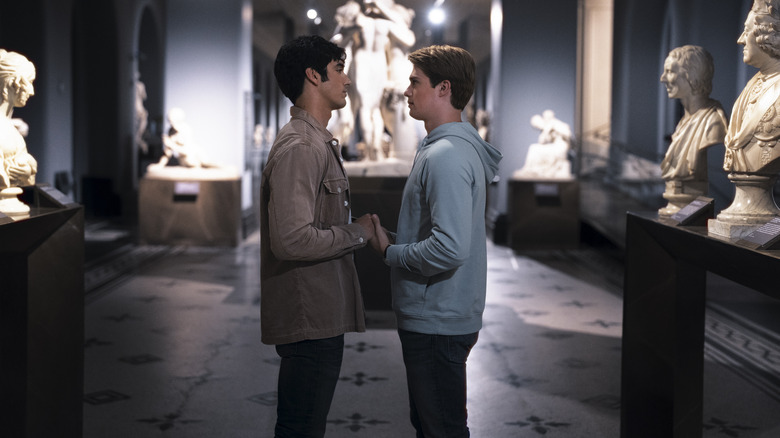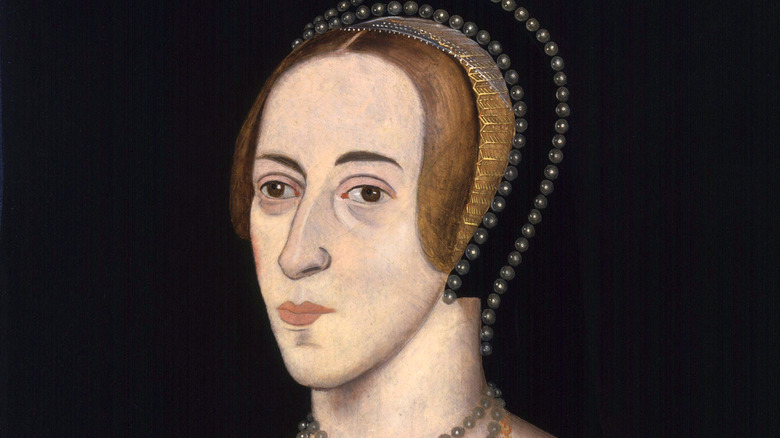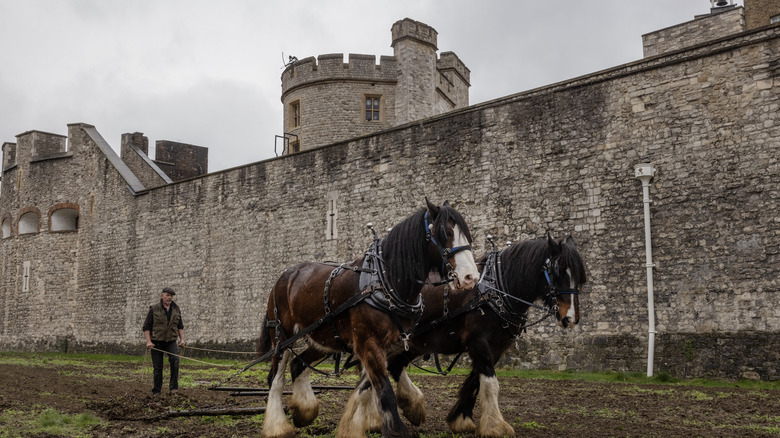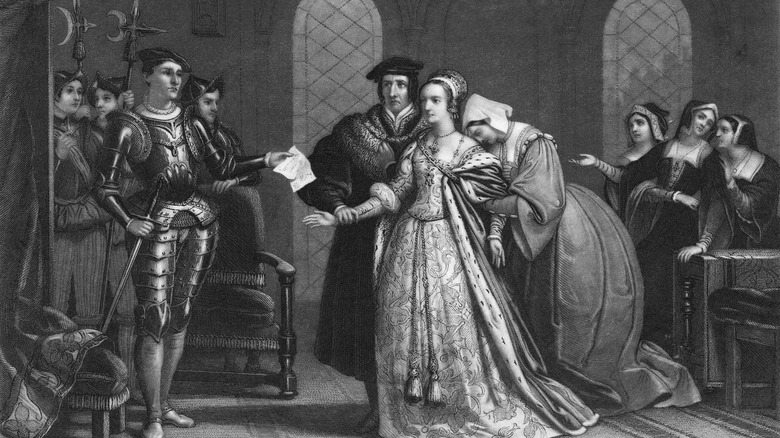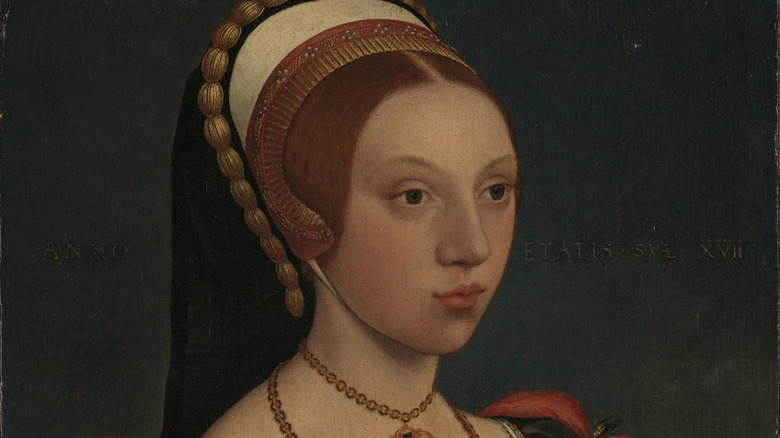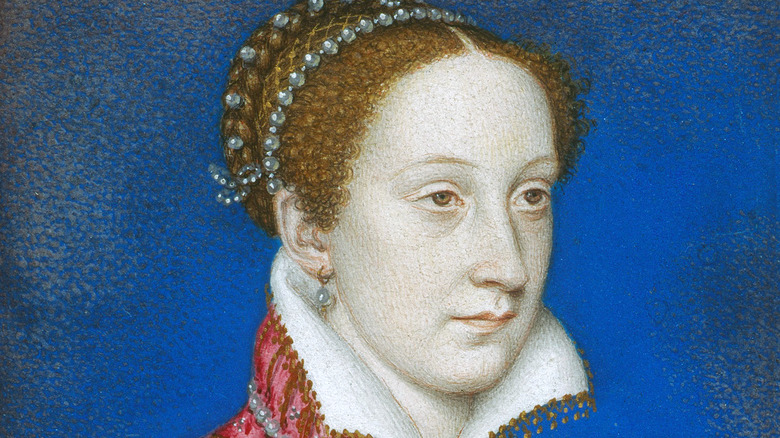Red, White And Royal Blue: Prince Henry's Dark English History Joke Explained
"Red, White & Royal Blue," based on the hit novel by Casey McQuiston, poses a pretty fascinating hypothetical: what if a fictional first son of the United States and Prince of England fell in love and had to contend with balancing their relationship and the geopolitical consequences of their connection? Brought to life by director Matthew Lopez and his stars Taylor Zakhar Perez and Nicholas Galitzine — who play first son Alex Claremont-Diaz and Prince Henry, respectively — "Red, White & Royal Blue" is Amazon's newest romantic comedy, and it's been delighting audiences across the world since it dropped on the streamer on August 11.
If you haven't checked the film out yet, it's absolutely worth your time — especially for this particularly grim joke made by Henry. As a member of the notoriously private, reportedly quite conservative British monarchy, Henry is terrified to come out as gay, even though Alex feels like he'll be ready after his mother's second presidential campaign is over. Alex, sharp as ever, quips that Henry's grandfather the king (Stephen Fry) can't just lock up a member of the royal family forever; Henry replies back that Alex should really brush up on his British history. Why? Oh, because kings and queens of England actually loved locking their family members up in the Tower of London. Here are a few examples.
Anne Boleyn was held in the Tower of London before her execution
If there's one thing Henry VIII loved, it was being really, really awful to his wives. He had six of them — because no matter how morbidly obese you become and no matter how much pus is leaking out of your leg at any given moment, you can still get as many women as you want if you're a monarch — and he famously mistreated each of them in turn. You've probably heard the rhyme: "Divorced, beheaded, died; divorced, beheaded, survived."
That first "beheaded" refers to Anne Boleyn, Henry's second wife, who rather infamously led to the king breaking with the Vatican and declaring himself head of the Church of England, which didn't go to his head in the slightest. Anne supplanted Henry's first wife, Catherine of Aragon, only to immediately deliver a baby girl and then miscarry several future children. This didn't sit well with Henry, who wanted a son and was also, as we've mentioned, extremely terrible to women, so he accused her of a whole host of crimes, including high treason, plotting to murder the king, and even incest with her own brother. In the lead-up to her execution, Anne was imprisoned in the Tower of London — the same place where she awaited her own coronation just a few years earlier — and she was beheaded on May 19, 1536.
Two princes were somehow lost in the Tower forever
One of the most enduring mysteries in British history concerns two young princes who were "lost" within the Tower of London — namely, King Edward V of England and Richard of Shrewsbury, Duke of York. See, the young Edward V was the son of the deceased King Edward IV and the still-living Queen Elizabeth Woodville, and he had the misfortune of being (nearly) crowned as the country's monarch smack in the middle of the contentious War of the Roses, which pitted family against family in a fight for the crown. After King Edward IV died in 1483, his brother, Richard told the intended King Edward V that he and his brother Richard could hang out in the Tower until it was time for the coronation. (Yes, there were only like, three names in circulation at the time, so just hang tight.) The future Richard III was, ostensibly, responsible for the well being of the boys, who were 12 and 9 years old... but after they were seen playing outside a few times, they completely vanished.
Were they murdered? Almost definitely, even though different men claimed to be the lost princes for years after the fact. Woodville was an extremely controversial player in this war — as a commoner who married a young king — and to make matters even shadier, Richard was next in line to become king after his nephews. He did become king, and while historians are mixed over who actually put a hit out on two literal children, there were plenty of parties with a vested interest in seeing those boys vanish.
Lady Jane Grey was queen for nine days before being banished to the Tower
Henry VIII gets a lot of attention for shoving people into the Tower of London and then dragging them back out to lop their heads off — go ahead and google Margaret Pole for a real doozy — but his daughters, Queen Mary and Queen Elizabeth, managed to get some blood on their hands as well. One such example is Lady Jane Grey, known colloquially as the "Nine Days Queen," who tried to "usurp" the throne from her first cousin once removed... and faced the consequences.
After marrying six different women, Henry only managed to produce one male heir, and unfortunately for his legacy, that kid was deeply unwell. Historical records indicate that King Edward VI, who was crowned after his father's death in 1547, was a sickly child — and the fact remains that he died at fifteen. So what does he have to do with Lady Jane Grey? Well, after getting seriously ill at the end of his life, he dictated that Lady Jane Grey should be named monarch after his death... because she was a Protestant in his preferred Church of England, and his older sister Mary Tudor was violently Catholic. Lady Jane Grey was crowned queen on July 10, 1553, and by July 19, she was supplanted by Mary and imprisoned in the Tower for high treason. Lady Jane Grey was ultimately executed in early 1554.
Catherine Howard was imprisoned before meeting an early end
Remember that little rhyme about how Henry VIII systematically subjugated and sometimes even murdered his own spouses? Well, the second "beheaded" refers to Catherine Howard, the younger cousin of the fellow beheaded queen Anne Boleyn. Catherine had the serious misfortune of being Henry VIII's fifth wife — which only lasted from 1540 to 1541 — and it's largely acknowledged by historians that, towards the end of his life, Henry's behavior was more erratic and impetuous than ever before. So how did poor Catherine Howard lose her head? Well, she was extremely young when she married Henry; her exact date of birth is unknown, but when he married her at forty-nine years old, she was somewhere between fifteen and twenty-one. As a result, she probably wasn't wildly attracted to him, and she was credibly accused of carrying on an affair with Thomas Culpeper, one of the king's courtiers. She also had a reportedly sordid history, and either had affairs with or was sexually abused by several men, including Francis Dereham.
After Henry accused her of infidelity, Catherine Howard's downfall was swift and brutal. She was imprisoned first at a former convent in Middlesex, Syon Abbey, before being moved to the Tower... where she saw the heads of Culpeper and Dereham proudly displayed. After a brief stay in the Tower, Catherine Howard was executed on February 13, 1542, and it's said that her vengeful ghost haunts one particular hallway in her former home, Hampton Court.
Mary, Queen of Scots threatened Queen Elizabeth's rule
The battle between Mary, Queen of Scots and Queen Elizabeth I is the stuff of legend — as recently as 2018, there was a movie made about it with Saoirse Ronan as Mary and Margot Robbie as Elizabeth — and it did lead to Queen Elizabeth imprisoning her first cousin once removed for a number of years. The daughter of King James V of Scotland, Mary was crowned when she was an infant and brought up in France, eventually assuming her throne in 1542. Unfortunately for her, the Scottish Reformation had thrown the very idea of the monarchy into question by this point, and not everybody was on board with Mary being the reigning queen. Fast forward to 1567, and Mary is basically forced to give up the throne and let her son James IV take the wheel (he was one year old at the time), and she ran over to England, hoping Queen Elizabeth might be able to protect her.
This was, to put it lightly, a terrible move on Mary's part. Mary was the great-granddaughter of Elizabeth's grandfather King Henry VII, and considering how many times Elizabeth was edged out of the line of succession over her controversial mother, she saw Mary as a possible threat. Mary also had a ton of Catholics on her side, so Elizabeth went ahead and imprisoned her cousin for over eighteen years all over England before Mary was found guilty of plotting to kill Elizabeth. She was executed on February 8, 1587 at Fotheringhay Castle in England.
